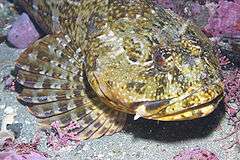Cabezon (fish)
| Cabezon | |
|---|---|
 | |
| Scientific classification | |
| Kingdom: | Animalia |
| Phylum: | Chordata |
| Subphylum: | Vertebrata |
| Infraphylum: | Gnathostomata |
| Superclass: | Osteichthyes |
| Class: | Actinopterygii |
| Subclass: | Neopterygii |
| Order: | Scorpaeniformes[1] |
| Suborder: | Cottoidei |
| Superfamily: | Cottoidea |
| Family: | Cottidae |
| Genus: | Scorpaenichthys Girard, 1854 |
| Species: | S. marmoratus |
| Binomial name | |
| Scorpaenichthys marmoratus (Ayres, 1854) | |
The cabezon (Scorpaenichthys marmoratus) is a large species of sculpin native to the Pacific coast of North America. Although the genus name translates literally as "scorpion fish", true scorpionfish (such as lionfish) belong to the related family Scorpaenidae. The cabezon is the only known member of its genus.[2]
Description
The cabezon is a scaleless fish with a broad bony support extending from the eye across the cheek just under the skin. Normally it has 11 spines on the dorsal fin. The cabezon also has a stout spine before the eye, an anal fin of soft rays, and a fleshy flap on the middle of the snout. A pair of longer flaps are just behind the eyes. The mouth is broad with many small teeth. The coloring varies, but is generally mottled with browns, greens and reds. >90% of red fish are males, whereas >90% of green fish are females. It reaches up to 99 cm (3 ft 3 in) in length and 14 kg (31 lb) in weight,[2] while the largest ever Cabezon caught was 25 lb (11 kg) in weight and longest being 39 in (99 cm).[3] As the Spanish-origin name implies, the fish has a very large head relative to its body.
Distribution and habitat
Cabezon are found in the northeast Pacific Ocean from Alaska to Baja California.[2]
They are found in a wide range of habitats at depths of 0–200 m (0–656 ft), including rocky, muddy and sandy bottoms, and kelp beds.[2]
Fishing technique
Cabezon feed on crustaceans, mollusks, fish and fish eggs. Cabezon are taken as a game fish, however their roe is toxic to humans,[2] because of the occurrence of a toxic phospholipid (Dinogunellin). Cabezon inhabit the tops of rocky ledges as opposed to rockfish and lingcod, which usually inhabit the sheer faces of these features.
References
- ↑ "Scorpaeniformes". Paleobiology Database. Retrieved November 15, 2012.
- 1 2 3 4 5 Froese, Rainer and Pauly, Daniel, eds. (2012). "Scorpaenichthys marmoratus" in FishBase. December 2012 version.
- ↑ "California Marine Sportfish Identification: Other Fishes". California Department of Fish and Wildlife. October 17, 2013. Retrieved March 21, 2018.
- http://www.nmfs.noaa.gov/speciesid/fish_page/fish66a.html
- International Game Fish Association "World Saltwater Records"
- Occurrence of a toxic phospholipid in cabezon roe